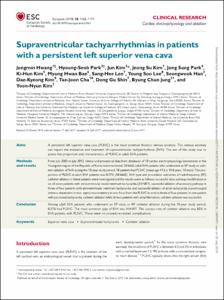KUMEL Repository
1. Journal Papers (연구논문)
1. School of Medicine (의과대학)
Dept. of Internal Medicine (내과학)
Supraventricular tachyarrhythmias in patients with a persistent left superior vena cava
- Keimyung Author(s)
- Park, Hyoung Seob
- Department
- Dept. of Internal Medicine (내과학)
- Journal Title
- Europace
- Issued Date
- 2018
- Volume
- 20
- Issue
- 7
- Abstract
- AIMS:
A persistent left superior vena cava (PLSVC) is the most common thoracic venous anomaly. This venous anomaly can impact the evaluation and treatment of supraventricular tachyarrhythmia (SVA). The aim of this study was to assess the proportion and characteristics of PLSVC in adult SVA patients.
METHODS AND RESULTS:
From July 2002 to July 2012, clinical and procedural data from databases of 10 cardiac electrophysiology laboratories in the Yeungnam region of the Republic of Korea were reviewed. Of 6662 adult SVA patients who underwent an EP study or catheter ablation of SVA during the 10-year study period, 18 patients had PLSVC (mean age 47.6 ± 14.8 years, 10 men). The proportion of PLSVC in adult SVA patients was 0.27% (18/6662). SVA type and procedural outcomes of radiofrequency (RF) catheter ablation in these patients were investigated and the results were as follows: successful slow pathway modification in six of seven patients with atrioventricular nodal reentrant tachycardia (AVNRT), successful ablation of accessory pathway in three of four patients with atrioventricular reentrant tachycardia, and successful ablation of atrial tachycardia (cavotricuspid isthmus-dependent in two, septal macroreentry in one, focal from the PLSVC in one) in three of four patients. In one patient with junctional tachycardia, catheter ablation failed. In two patients with atrial fibrillation, catheter ablation was successful.
CONCLUSION:
Among adult SVA patients who underwent an EP study or RF catheter ablation during the 10-year study period, 0.27% had PLSVC. The most common type of SVA was AVNRT. The success rate of catheter ablation was 82% in SVA patients with PLSVC. There were no procedure-related complications.
- Keimyung Author(s)(Kor)
- 박형섭
- Publisher
- School of Medicine (의과대학)
- Citation
- Jongmin Hwang et al. (2018). Supraventricular tachyarrhythmias in patients with a persistent left superior vena cava. Europace, 20(7), 1168–1174. doi: 10.1093/europace/eux164
- Type
- Article
- ISSN
- 1532-2092
- Source
- https://academic.oup.com/europace/article/20/7/1168/3876186
- Appears in Collections:
- 1. School of Medicine (의과대학) > Dept. of Internal Medicine (내과학)
- 파일 목록
-
-
Download
 oak-2018-1541.pdf
기타 데이터 / 487.48 kB / Adobe PDF
oak-2018-1541.pdf
기타 데이터 / 487.48 kB / Adobe PDF
-
Items in Repository are protected by copyright, with all rights reserved, unless otherwise indicated.